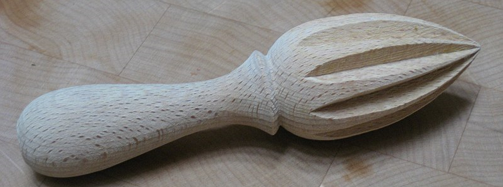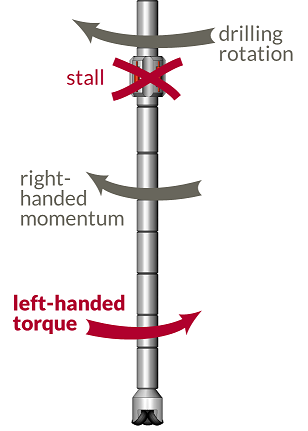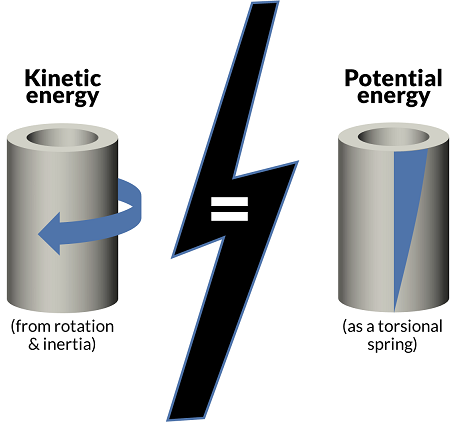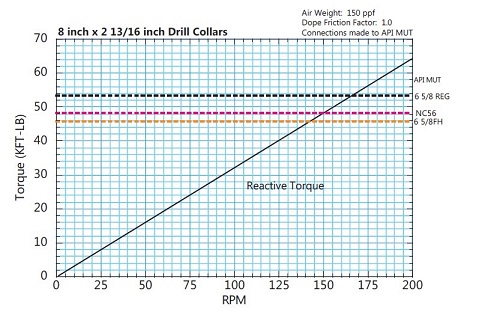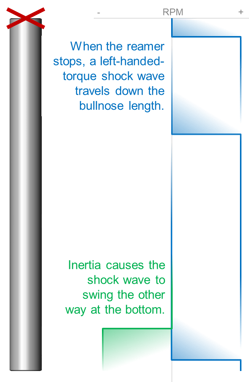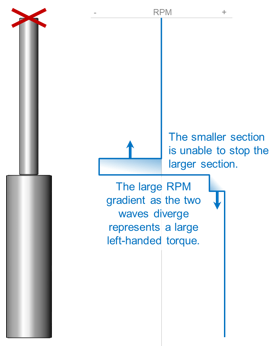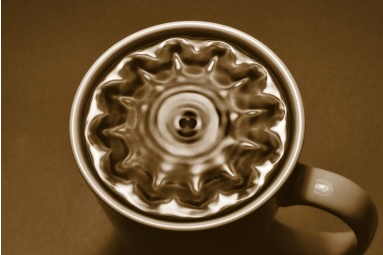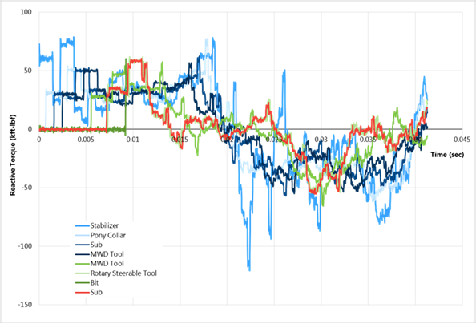When You Come to a Fork in the Road
In rotary drilling we all-but-always rotate our string to the right, which is a choice that affects an awful lot of other things. For instance, many tools that have to “set” or “activate” or “do a dance downhole in some ineffable way” do that when the tool’s turned to the left, simply because you don’t normally turn to the left, so you’re unlikely to “dance” accidentally. More to my current point, our connections are right-hand threaded, so that turning to the right makes them tighter, not looser. (If it does anything—ideally you’re not making your connections up downhole, remember?)
(Totally unrelated, but I just this instant learned how to do that link-to-highlighted-text-in-a-webpage thing. Those clever JavaScriptionists …)
Anyhoo, turning to the right is the way we drill, which is why we’re usually pretty surprised (and peeved) if we back our connections off whilst in the hole. I’ve talked before about one way to do that—you might cause a whole mess of torsional vibration if you set your top drive torque limit too low, even to the point that you can back off a connection (I seen it afore). Now, though, I’m going to look at another way that your string might partially disappear.
Imagine you have a reamer.
No! Gosh, an under-reamer / hole-opener thing in your drillstring. (I’m trying to not use trademarked names, but you know what I’m talking about.) Underneath said reamer you will arrange several heavy things to increase the tension that’s pulling the reamer through the formation.
As something of a sidebar, those heavy things are a good idea. Our industry started by treating reamers as if they were bits, just stacking compressive weight on top of them to push them through the rock, which led to breaking crap off. See, a bit can’t really buckle, in the sense that even if the collars on top of it are buckled, the bit can’t maintain any bending moment because it’ll just steer that direction as it drills. But a reamer? Oh, man, you can buckle the snot out of a reamer because there’s stuff above and below it.
Now just visualize a buckled reamer being rotated and trying to enlarge the hole. Any arms or cutting elements are going to contact sporadically, rotating into and out of the formation because the reamer itself is cattywompus to the hole. This, of course, will hammer the poor thing to bits, which is more or less what we did with the first generation of HoleOpenReamerTools.
But if you “pull the reamer” (by which I mean don’t buckle it while you’re rotating), things go much more smoothly. You don’t break the tool, which is obviously good, and you drill faster, which is even more gooder.
Arright, so now there’s a “bullnose” or a length of collars below the reamer to increase the tension at the reamer and avoid buckling there. Well and good. But, in the same way that we can get stick-slip in our bit, we can also see it in our Reamerator. When a bit sticks, the components above it see a higher-than-average torque. When an OpenYerHoler sticks (I’m having way too much fun with dumb reamer names), the connections above will see a higher torque, but the connections below will see a left-handed torque as the reamer tries to get them to stop spinning.
We give it a name to avoid having to go through that whole blasted explanation every time we mention it: Reactive Torque.
A reactive torque failure, then, is when that left-handed torque is high enough that it backs the connection off, which falls in the hole. Which is less than good.
In order to avoid reactive torque failures, we want to make sure that we don’t back off those connections. Accuracy here could get … complicated. The precise torque that it takes to break out a connection is often about 80% of the makeup torque you applied, but sometimes it’s more or less (90% or 70% or 110% or some other %) due to circumstances which are largely unpredictable about the way your thread dope behaves when it’s sent down hole. There’s also the tensile or compressive load that will shift the break out torque, and a few other complications like temperature and relative pressures.
To cut that Gordian knot, let’s just keep it simple: MUT > Reactive Torque is safe. (Use a safety factor if you’re concerned about the other stuff. We usually use a safety factor of 15%-ish, but we’re flexible depending on the scenario.)
Treating this like an overload failure then, I need the load capacity—makeup torque in this case—and the load—which would be the left-handed reactive torque that will be applied if the HoleBiggifier stops suddenly. This also will be wildly difficult to accurately calculate. It would require solving a torsional vibration problem, understanding the exact time-based responses of a complex string section to torque from above and below and the sides (friction with the wellbore), all interacting in non-linear ways. (“Non-linear” is mathematician speak for “we have no freakin’ clue.”)
This brings me to a fork in the road, and I’m going to follow Mr Berra’s advice and take it.
The first way I can calculate reactive torque loading is to grossly oversimplify. I’m going to consider that my rotating bullnose possesses a certain amount of rotating kinetic energy. If it stops, then that energy is no longer kinetic (because it ain’t movin’), but potential—it must have wound up the bullnose like a left-handed torsional spring. If I calculate how much left-handed torque applied to my bullnose would store the same amount of potential energy as the original kinetic energy, I’ll know the maximum reactive torque load that could be applied to my connections.
So let’s puzzle: what can I do to change the reactive torque my connections see? The kinetic energy is carried by mass and speed. So if your collars are heavier, then there’s going to be more kinetic energy, and more reactive torque as a result. If your collars are lighter, contrariwise.
If you’re rotating faster, that’s also going to increase your kinetic energy and the resulting reactive torque. In fact, that’s probably the biggest thing you can change easily: if reactive torque is a concern, slow your roll.
If you double the length of that bullnose, you double the mass, which doubles the kinetic energy. But you also double the energy storage capacity of our torsional spring. So … the reactive torque stays the same.
One more time: the length of your bullnose doesn’t affect the reactive torque.
That goes right in the face of a great deal of folk wisdom; I’ve heard people confidently insist that long bullnoses are more likely to back off due to reactive torque. When I dig into why they say that, I usually get “well, it just makes sense.” But science says otherwise—as does our experience. Longer bullnose sections don’t make any difference in your risk of reactive torque failure.
Ok, let me ponder how good or bad this modeling is at giving me an accurate left-handed torque.
I pondered; it’s bad.
Imagine all the ridiculous assumptions I’m making:
- No Friction: Saying “all the kinetic energy turns into potential energy” means it didn’t go anywhere else—like being rubbed off in friction. Which is absurd.
- Instant Stop: Since we’re not actually fixing the ends of the bullnose into a twist, the idea that my potential energy is stored in torsional strain requires me to presume that the top of the string comes screeching to a halt in an infinitesimal amount of time. Otherwise it wouldn’t be acting like a torsional spring, it would be turning as a rigid body. But I know it’s going to take some real amount of time to stop the LargiHolemator, so this is another dumb assumption.
- No Vibration: My calculation here has me determining kinetic energy in one steady state, then closing my eyes and saying “nunga-nunga-nunga,” then opening them to another steady state. Since reactive torque is clearly a time-based phenomenon, this, too, is crazy-town.
But here’s the thing: as bad as all these assumptions are, they’re bad in the good direction. That doesn’t make sense—I mean they’re all conservative, they will all give me an answer that is bigger than the actual left-handed torque that my connections will see. So if I do this ridiculous modeling and it says my connections are safe, I’m pretty dang sure that my connections are safe.
This, by the way, is the method given in the “Special Problems” section of DS-1 Volume 2, aka “Nerdland.” (Casing wear, slip crushing, stuck pipe—oh my!) We briefly outline this calculation method, then give some pretty graphs for some standard scenarios to help you out.
Usually, usually, this is as far as you need to take it. This “energy method” does a perfectly acceptable job of keeping your bullnose hanging on like the “almost Friday” cat.
You know there’s a “but” coming, right? There’s just one thing buried in my list of ridiculous, conservative assumptions that turns out to not be conservative (but still ridiculous). It’s hiding in the “no vibration” nonsense—if your bullnose includes a big change in cross-section, you can’t help but create torsional vibration that might hurt you.
Why a section change? Well, if there is no section change, then my stupid assumption about “instantaneous stoppage” is actually not too far off. If the Enlargementator sticks, then a left-hand-torque shock wave shoots down the length of the bullnose. The magnitude of said shock wave is exactly what we calculated in our energy method. When the shock wave gets to the bottom of the string, inertia causes it to swing the other way, sending a right-hand-torque shock wave back up the string. Even in the absence of friction (not real life), it would just bounce back and forth forever and never get any bigger, so you’d be safe.
But if there’s a large section change in your bullnose, the shock wave doesn’t have the guts to stop that big section’s momentum, so part of the wave keeps moving down, but part of it bounces back up the string. That creates a large RPM gradient at that spot, which translates to a left-handed torque value that’s bigger than what our energy method would have calculated.
Unfortunately, bullnoses with a big section change (and not a lot of help in the frictional damping department) are de rigueur for the big shallow sections in deepwater wells. So in these cases I have to take the second fork of my Yogi-Berra-ism, and figure out how to use the equation of motion to describe torsional vibration in my bullnose:
Ok, I’m thinking my readership is not quite patient enough to stay with me while I do that kind of math. Especially since there won’t be a classical answer because we’re interested in multi-sectional strings, so I’m going to have to solve it using a numerical algorithm both to find the vibrational modes and to understand how they’re activated with a torsional impulse.
Ok, sorry, I’m back. I got lost in applied mathematics and French history (did you know d’Alembert’s momma left him on the steps of an orphanage?). The point: you can solve it (numerically, at least) and determine whether or not you’re going to get a left handed torque that’s troublesome. I know you can solve it, because I did it (for an SPE paper), and I just know that you can, too.
(You know I had to put in an impressive-looking graph.)
With all that work, you may consider the fact that the torsion equation of motion and the longitudinal equation of motion are identical in form. Thus, with a few number changes you’ll be able to reuse your code to find longitudinal shock results as well. That may not be useful quite as often, but it does happen, say when somebody drops something accidentally …
To summate: stick-slip in your BoreWidifier might cause you to unscrew a connection below it. To avoid that, you usually calculate the maximum reactive torque possible using a simple (and simplistic) energy method that’s wrong but mostly conservative. If you happen to be using a bullnose with a big section change, though, you’ll want to consider creating a vibration solver that can deal with that. (And by that, of course, I mean give us a call. You’ve got better things to do, right?)
Also, for tool-company marketing departments: I await your call about licensing one or more of the original and memorable tool names I’ve listed above. My terms will be quite reasonable, I assure you.
